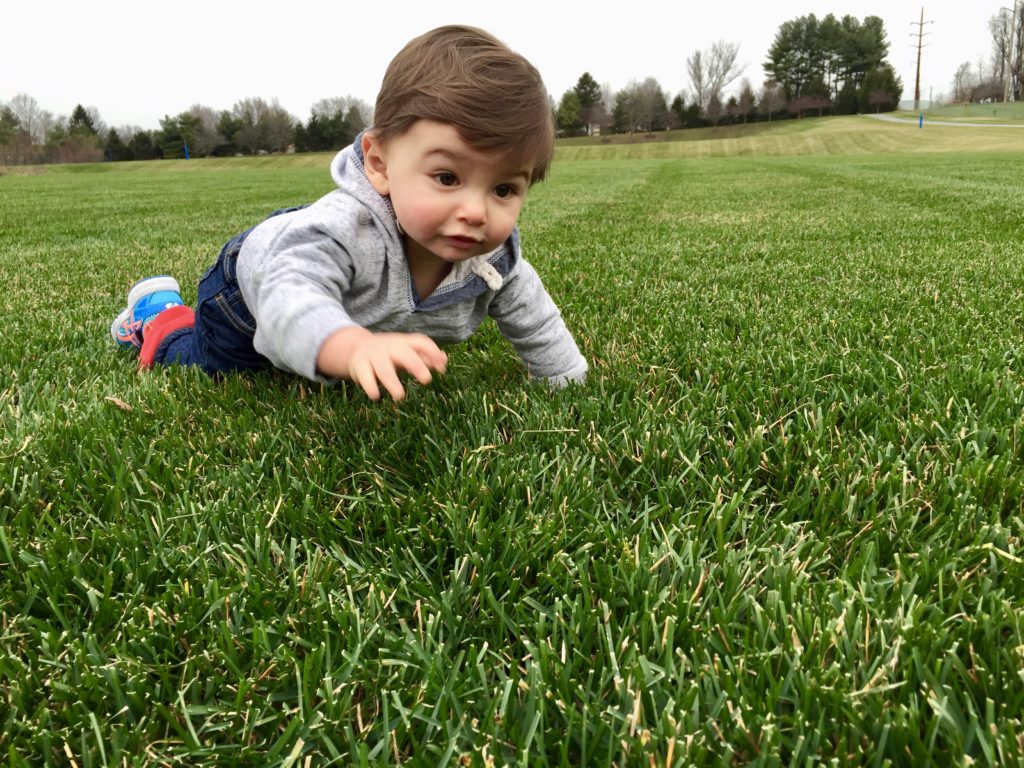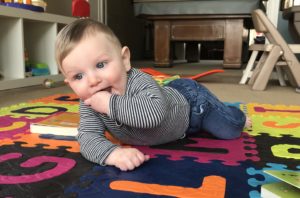
We applaud the first roll over, video the first step, and record the first words in baby books, but what about the first time your baby creeps across the floor? This is perhaps the most important developmental milestone, but definitely the most unappreciated. It is sometimes regarded as a nuisance milestone because the baby is suddenly on the move and we have to childproof, scrub the floors, and keep the family pet out of the way. If you have hard wood floors that are hard on the little knees, put down throw rugs or blankets for your baby to crawl on to encourage him to crawl on all fours.
Benefits of crawling:
- Crawling strengthens your baby’s trunk muscles. Think planking for babies. Just as a 30 second plank does wonders for our core, strengthening our abs, back muscles, obliques, shoulders, and hip girdle, crawling does the same for babies. Because babies develop from head to toe and from their trunk, outward, a strong core is the foundation for the rest of their strength, coordination, and dexterity. The weight-bearing through the shoulders and hips build the strength necessary for good posture and motor skills.
- Crawling helps both sides of the brain work together. Because the left side of our brain controls the right side of our body and vice versa, the two sides of your baby’s brain need to learn to work together for your baby to have coordinated movement on both sides of their body. The reciprocal action of crawling helps to stimulate this and teaches the brain to work together, thereby, the motor skills become more coordinated from left to right.
- Crawling helps the development of your baby’s visual skills. His vision is still developing throughout the first year when crawling is naturally occurring, so during this time your baby’s world is still very close to him. He does not have 20/20 vision of an adult. His vision is still developing well past his fourth birthday. When your baby is crawling on the floor, his toys are all within eight to 36” from his face, which is the field where his vision is most acute and he can see most clearly. He is also gazing at the floor and ahead of him while crawling which strengthens the tiny muscles around his eyes, improving his visual motor skills. Crawling also helps to develop binocular vision, or the ability to look ahead in the distance, then back down at his hands while crawling.
- Crawling strengthens your baby’s hands and builds fine motor skills. Because your baby is weight bearing on her hands while crawling, the musculature of her hands is strengthened and she will have better dexterity for grasping items, coloring, holding a pencil, and eventually, writing.
- Crawling helps with balance. It takes some skill to balance on all fours and this is an important building block for walking.
- Crawling improves your baby’s spatial skills. Crawling requires some pretty sophisticated navigating over toys, under chairs, around table legs, and through mommy’s legs. This understanding helps your baby learn about his world, his own body awareness, and begins to lay the groundwork for higher-level critical thinking.
- Crawling builds self-confidence. It can be scary to venture off away from mommy and daddy for the first time, but taking these risks will help your baby discover his potential and limitations while he explores his world on his own.
 Crawling doesn’t just happen overnight. It is a long process of scooting, creeping, rolling, then eventually pulling those little knees underneath their body to propel themselves forward. Encourage crawling! Get down on the floor with your baby and place toys just out of reach. Some babies will pull themselves to standing and try to go straight to walking, skipping the crawling milestone altogether, but encourage her to get back to all fours. Once your baby masters walking, she will have little time for crawling and all of these great benefits are missed.
Crawling doesn’t just happen overnight. It is a long process of scooting, creeping, rolling, then eventually pulling those little knees underneath their body to propel themselves forward. Encourage crawling! Get down on the floor with your baby and place toys just out of reach. Some babies will pull themselves to standing and try to go straight to walking, skipping the crawling milestone altogether, but encourage her to get back to all fours. Once your baby masters walking, she will have little time for crawling and all of these great benefits are missed.
References:
Aamodt, S. & Wang, S. (2011). Welcome to Your Child’s Brain: How the Mind Grows from Conception to College. Bloomsbury, NY.
Leach, P. (1997). Your Baby & Child. Random House.
Plas, X., & Plooij, F. (2017). The Wonder Weeks Milestone Guide. Your Baby’s Development, Sleep, and Crying Explained. K.W. Publishing.
Zero To Three (2018). https://www.zerotothree.org/resources/202-steps-toward-crawling

